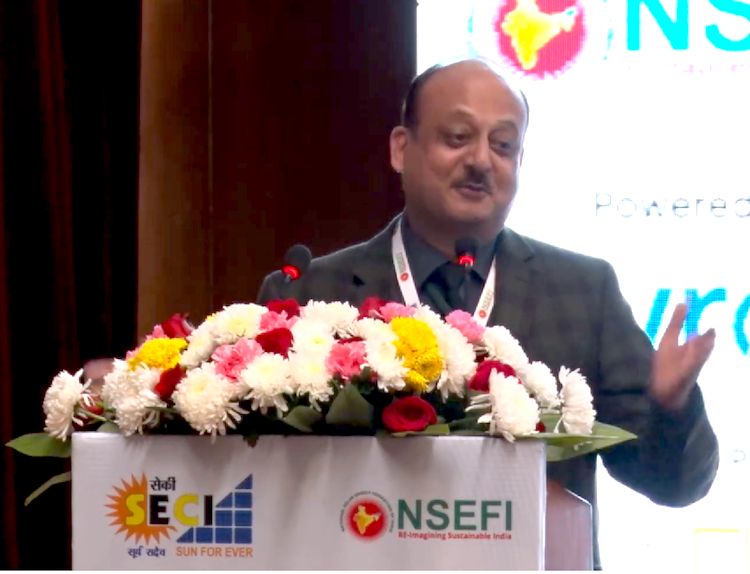India’s CSP tender described by Ajay Kumar Sinha, AGM of Contracts & Procurement at SECI (Solar Energy Corporation of India)
India’s CSP tender is making waves. NTPC has carved out an unprecedented over-50% for concentrated solar thermal technologies in its renewables tender, and has also just been reported to have announced a 500 MW tender already.
The news of the tender attracted the world’s key CSP developers and stakeholders to the International Conference on Solar Thermal Technologies, organized by Rajan Varshney, Deputy General Manager of NTPC; India’s largest electricity supplier.
Representatives from the legislative and policymaker sides confirmed the commitment to the extraordinary new policy, which exceeds even China’s CSP requirement for 100 MW of CSP in each 1 GW renewable energy park.
Along with the requirement itself, well-designed additional incentives should cut the risk to CSP developers. These include free permitting, guaranteed grid connection, and very long, low-cost leases on pre-vetted land with excellent DNI, the solar resource utilized by concentrated solar thermal energy.
Generous incentives to be nationwide in India’s CSP tender
When we spoke in December, Varshney described a tender for just the region covered by NTPC. As India’s largest electric utility, NTPC territory is huge but not nationwide.
At the conference describing India’s CSP tender, national government officials expressed strong support for applying these new policies to the entire nation. With legislator buy-in now at the national (Unity Government) level, Varshney confirmed that these policy incentives would now apply throughout India, in the regions vetted for excellent DNI, the solar resource used by concentrated solar technologies.
“We will try to give for free all the clearances, and we can guarantee grid connection, and offer long-term contracts and facilitate loans for them,” Varshney told SolarPACES in a December interview.
“Already in high DNI areas, some entities are acquiring land for a 99-year lease to the developer so that all the IPP has to do is build, own, and operate. He doesn’t have to transfer. He doesn’t have to bother about all these other things like land acquisition and power evacuation.”
International developers and key suppliers, including ACWA Power, SENER, John Cockerill, Vast and Cosin Solar acknowledged the implications of such a policy.
“Having a piece of land fully permitted without any risk on the agreed interconnection or the ownership of the land? That makes a huge difference,” said Pedro Cabanillas from John Cockerill. The firm supplies key components like receivers to today’s biggest CSP projects.
Real dialogue between policymakers and stakeholders
Questions from the audience for policymakers about India’s CSP tender were quite pointed: How can we achieve a 90% guaranteed solar energy delivery each month when three months of the year is a monsoon?
Representing CECI (Solar Energy Corporation of India), Ajay Sinha, in Contracts & Procurement, was open and receptive to the issue, suggesting that any needed policy adaptation would make it work: “Definitely we’ll look into that, and somehow we will try to answer yes.”
Citing the example of how Spain’s government abruptly cut solar tariffs mid-contract, local contractors wanted to be reassured about the long-term reliability of the new, very generous legislation.
CECI’s Sinha explained that the 25 or 30-year PPAs would be binding private PPAs, so developers have security over their lifetime: “We don’t prescribe setting tariffs in general. We prefer to keep it open for the market to decide.”
As one solution to monsoon-driven sunless months, CEO Craig Wood from Vast proposed green hydrogen or ammonia for storage, noting: “We think in the longer term, the opportunities in green fuels are potentially more interesting and more lucrative and larger than some of the power generation opportunities. We can use that heat directly from process heat applications. Or we can use the combination of the heat and power to provide green fuels.”
Vulcan Energy CEO Siddharth Malik from Oman and spokeswoman Theresa Gong from China’s Cosin Solar also suggested retrofitting coal or gas power stations as thermal energy storage.
“Some countries close those coal power plants,” Gong said. “But when there are coal or gas-fired plants of which there are still PPA years but now the agreement targets are in the zero carbon target, we can consider adding molten salt storage to the plant and to replace the coal, the coal burner coal boiler and we can take in the cheap, renewable energy or curtailed renewable PV or wind energy and store that in the form of molten salts and then generate power when during the peak hours.”
International developers received equally focused audience questions.
“How long do molten salts last? How often do you change them?” They essentially don’t degrade over a 35-year contract, explained Cabanillas.“The salts last. There’s no need to change them.”
What was the total cost, including borrowing, for ACWA Power to build the 700 MW DEWA CSP project? $4.3 billion. (DEWA comprises three 200 MW trough CSP plants and a 100 MW tower CSP plant and contracted in 2017 to sell the power at 7.3 cents/kWh)
The background condition for India’s CSP tender decision is the rise of battery adoption, according to Ajay Shankar, Distinguished Fellow, Director-General’s Office at The Energy and Resources Institute.
Shankar had been involved in designing the initial solar tender in 2010 designed to get 20 GW online by 2022. India has far exceeded that goal with 70 GW. But like many countries choosing the cheaper solar first, India now has to rely on the ever-increasing deployment of batteries for storage, as PV unlike CSP does not store solar energy itself.
”Now concentrated solar thermal with storage is a much better option than batteries, which are being propagated worldwide,” he declared.
“And for India, we need to go very speedily in this direction because our renewable transition is being pushed by PV where we don’t get to see any electricity at night. We need storage now. We need to bring CSP in quickly and scale up rapidly.”
Shankar noted how in its early push for renewables 14 years ago India had already bucked the international trend towards tariffs.
The lessons for policymakers from the huge success of India’s National Solar Mission
“When we began our National Solar Mission, we were told that auctions with bids are not a good idea,” he recalled. “Nobody in the world has done it. Germany has succeeded with feed-in tariffs. We were told why not prescribe technology or conversion efficiency. We were a little forward looking when we said we’ll invite bids.”
Shankar approved the current policy design of simple auctions with no floor, no limits. He pointed out that the National Solar Mission was so successful because the land and environmental permitting was guaranteed and commended the decision to take the same approach now for CSP.
“Putting the land together, getting the environment permitting streamlined was the only two things we did,” Shankar affirmed.
“But the price bids we got were 30% lower than my most optimistic estimate. And therefore in CSP again if we can do risk mitigation in consultation with potential bidders in developers, as we invite bids, I think we get very attractive prices. And we can and should be on the global frontier in deployment of CSP with storage because as the central exchange authority has said; we need 74 gigawatts of storage by 2032. That’s a huge number. We have practically nothing.”
Future-oriented climate planning led to China prioritizing CSP
The post India’s CSP tender (over 50%) attracts international stakeholders appeared first on SolarPACES.


